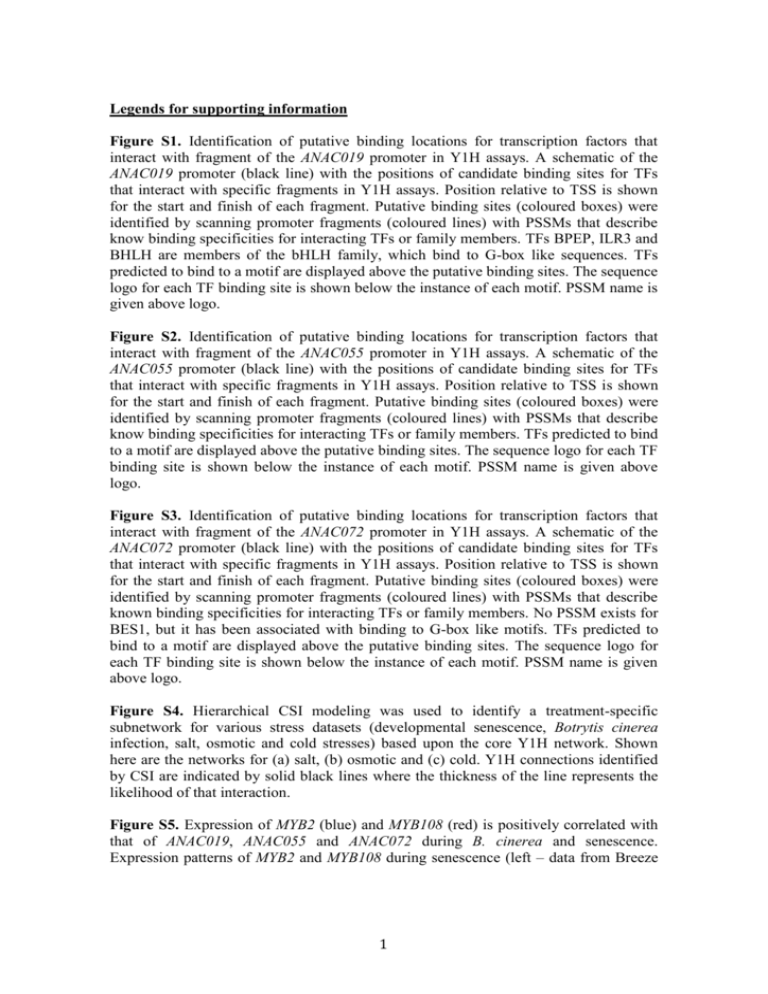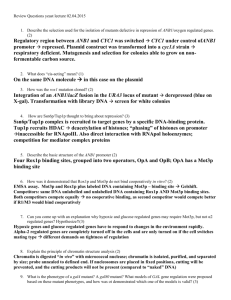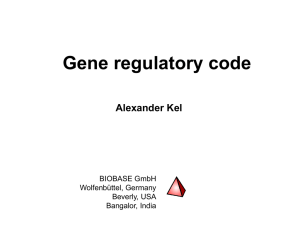tpj12194-sup-0011-Legends
advertisement

Legends for supporting information Figure S1. Identification of putative binding locations for transcription factors that interact with fragment of the ANAC019 promoter in Y1H assays. A schematic of the ANAC019 promoter (black line) with the positions of candidate binding sites for TFs that interact with specific fragments in Y1H assays. Position relative to TSS is shown for the start and finish of each fragment. Putative binding sites (coloured boxes) were identified by scanning promoter fragments (coloured lines) with PSSMs that describe know binding specificities for interacting TFs or family members. TFs BPEP, ILR3 and BHLH are members of the bHLH family, which bind to G-box like sequences. TFs predicted to bind to a motif are displayed above the putative binding sites. The sequence logo for each TF binding site is shown below the instance of each motif. PSSM name is given above logo. Figure S2. Identification of putative binding locations for transcription factors that interact with fragment of the ANAC055 promoter in Y1H assays. A schematic of the ANAC055 promoter (black line) with the positions of candidate binding sites for TFs that interact with specific fragments in Y1H assays. Position relative to TSS is shown for the start and finish of each fragment. Putative binding sites (coloured boxes) were identified by scanning promoter fragments (coloured lines) with PSSMs that describe know binding specificities for interacting TFs or family members. TFs predicted to bind to a motif are displayed above the putative binding sites. The sequence logo for each TF binding site is shown below the instance of each motif. PSSM name is given above logo. Figure S3. Identification of putative binding locations for transcription factors that interact with fragment of the ANAC072 promoter in Y1H assays. A schematic of the ANAC072 promoter (black line) with the positions of candidate binding sites for TFs that interact with specific fragments in Y1H assays. Position relative to TSS is shown for the start and finish of each fragment. Putative binding sites (coloured boxes) were identified by scanning promoter fragments (coloured lines) with PSSMs that describe known binding specificities for interacting TFs or family members. No PSSM exists for BES1, but it has been associated with binding to G-box like motifs. TFs predicted to bind to a motif are displayed above the putative binding sites. The sequence logo for each TF binding site is shown below the instance of each motif. PSSM name is given above logo. Figure S4. Hierarchical CSI modeling was used to identify a treatment-specific subnetwork for various stress datasets (developmental senescence, Botrytis cinerea infection, salt, osmotic and cold stresses) based upon the core Y1H network. Shown here are the networks for (a) salt, (b) osmotic and (c) cold. Y1H connections identified by CSI are indicated by solid black lines where the thickness of the line represents the likelihood of that interaction. Figure S5. Expression of MYB2 (blue) and MYB108 (red) is positively correlated with that of ANAC019, ANAC055 and ANAC072 during B. cinerea and senescence. Expression patterns of MYB2 and MYB108 during senescence (left – data from Breeze 1 et al., 2012) and response to B. cinerea infection (right – data from Windram et al., 2012). Figure S6. Gene expression patterns of selected genes representing GO terms identified as being enriched at one or more timepoints during the experiment. Mutant expression (blue lines) are compared to wild type (red lines). a) Certain photosynthesis genes are upregulated in the anac019 mutant (e.g. LCHA4) while others (e.g.SBPase) are downregulated in the anac055 mutant. b) SA signaling genes such as AHBP-1B are down regulated in the anac019 KO mutant while JA signaling and biosynthesis genes such as LOX2 and AOS are upregulated. c) SA response genes such as WAK1 are upregulated in the anac055 KO mutant, ethylene and JA response genes such as ACS6 and JAZ7, are down regulated together with many stress related genes such as SAT32, RHA2A and EDS5. Table S1. Genes differentially expressed in the anac019 mutant compared to Col-5 WT control over the whole time course were identified using GP2S sampling (Stegle et al., 2010) and genes with a GP2S score >5 were retained. A 2 sample Student’s t-test was used to identify genes significantly altered between Col-5 and anac019 at each time point. These were sorted into up and down regulated genes using the ratio of the average mutant expression levels to average control expression levels. BiNGO analysis (Maere et al., 2005) was used to identify overrepresented GO terms in genes up or down regulated at each time point in the anac019 mutant compared to WT at each time point. Table S2. Genes differentially expressed in the anac055 mutant compared to Col-0 WT control over the whole time course were identified using GP2S sampling (Stegle et al., 2010) and genes with a GP2S score >5 were retained. A 2 sample Student’s t-test was used to identify genes significantly altered between Col-0 and anac055 at each time point. These were sorted into up and down regulated genes using the ratio of the average mutant expression levels to average control expression levels. BiNGO analysis (Maere et al., 2005) was used to identify overrepresented GO terms in genes up or down regulated at each time point in the anac055 mutant compared to WT at each time point. 2






